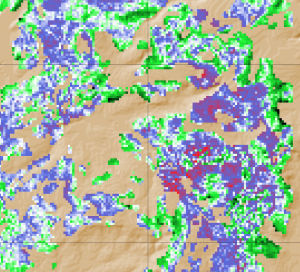A new direction for resource modelling

In mining, risk is a massive factor in decision making.
From exploration to rehabilitation, risk is inevitable. It isn’t inherently good nor bad; with great risk can come great opportunity.
One way geologists mitigate risk in resource modelling is by thorough grade estimation processes and reliance on the ‘competent person’ to validate each and every decision. The goal is to reduce risk by demonstrating that a project is financially viable.
Machine Learning methods are set to vastly improve the speed, consistency and accuracy of current grade estimation techniques. Here’s how:
Once a deposit is pronounced potentially mineable, further drilling, assaying etc. is necessary. As more information comes in, the evaluation process is repeated and the model is refined. Each iteration involves the dedication of time and resources … until eventually the risk, or degree of uncertainty, is considered acceptable.
Using estimation algorithms for resource modelling requires attention to detail. For example setting up a single variable in a single geological domain using the inverse distance technique could entail up to 190 decisions.
Applying ordinary kriging to a single variable/domain can take up to 170 decisions in preparation alone to determine appropriate parameter settings, followed by a further potential 220 decisions to carry out the kriging estimate.
A deposit with a single commodity of economic interest within a single uniform geology is rare. For example, one Maptek customer has approximately 900 variable/geological domain combinations. Applying kriging to the entire deposit requires about 35,000 decisions!
Little wonder that generating an ore resource report can involve weeks or months of geological effort. The competent person often lacks the time to validate each and every decision.

Reaching the rapid modelling goal
Read the Forge article on this topic
Disruptive technology has always been part of mining.
Computing replaced hand-drawn maps and manual calculations. Software algorithms race to outpace each other. Pioneers bear the risk and reap the benefits of being early adopters.
Current mathematical grade estimation techniques do not, in themselves, deliver realistic grade estimations. Geologists who provide an intuitive understanding of the deposit geometry are the key to guiding algorithms to the ultimate goal of chasing better ore predictions. And herein lies yet another risk factor for operations. This vitally important knowledge is near impossible to embed, nor is it consistent between geological practitioners.
Machine Learning techniques, which have been applied in other industries for more than two decades, can do precisely this. This is how miners can future-proof their operations.
Maptek has been at the forefront of mining technology for 40 years because we continually ask ‘Is there a better way to do this?’ As we have watched Machine Learning transform other industries, we asked that question, and again, realised the answer is ‘Yes.’
Through consultation with key customers Maptek has developed a new solution to expedite resource modelling and reporting. 
Machine Learning can progress evaluation projects from database to report in 30 minutes.
All stakeholders can ‘learn’ the intricacies of their orebody because the Machine Learning engine essentially does the learning for them, producing a consistent model that allows the entire operation to reap the benefit.
As a geologist who provides technical expertise to mine sites across Australia and Asia-Pacific, I believe that Machine Learning will make waves in the resource modelling space. I am excited to be working with mines keen to explore a new approach.
Is there a better way to do resource modelling?
Yes.





